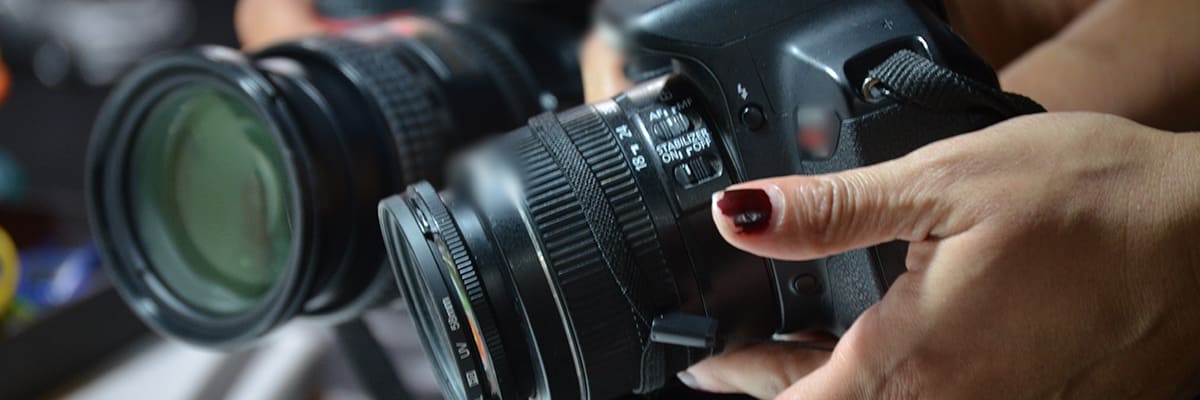
Return navigate_next
Three Must-Haves When Choosing a Camera Warranty
August 1, 2021 *
However you use your camera equipment, it’s important to take good care of it. Lenses, in particular, are easy to damage. If they can’t be repaired, they’re often extremely costly to replace.
With that in mind, many camera owners use an extended camera warranty. Extended warranties, service contracts, and insurance policies are a great way to ensure peace of mind. Yet, with so many options to choose from, finding the best camera, camera lens, or video camera warranty is often no easy feat.
To help make choosing a little easier, here are three must-haves when selecting a policy for any piece of camera equipment.
Accidental Damage Protection
Accidents happen – everyone knows that. Thankfully, extended warranty and insurance policies help safeguard against such eventualities. These eventualities may include screen cracks or damage resulting from accidents and drops, for example, or damage caused by accidental liquid spills or submersion.
However, it’s vital to remember that manufacturers’ standard and limited warranties do not include this level of coverage.
To ensure that a piece of camera equipment is protected against accidental damage, extended coverage is required. For this reason, upgraded policies are regularly sold at the point of sale when buying camera equipment. The second agreement runs alongside a manufacturer’s limited warranty, providing additional benefits, such as accidental damage protection.
Not all extended warranties include this level of coverage. As this is frequently one of the most significant benefits of any warranty package, always double-check to make sure that accident protection is included.

Coverage Against Mechanical Failures
All warranties typically cover manufacturer and manufacturing defects. Manufacturers’ standard warranties, which are included with most purchases, are designed to offer customers reassurance surrounding their products.
Limited warranties usually last for just 12 months, and such protection may extend solely to specified parts and particular manufacturing defects. Quite often, this means that a whole host of potential mechanical issues aren’t covered.
To ensure that your warranty covers unfortunate mechanical failures, an extended warranty is necessary. Look for an agreement that covers failures concerning:
- Motors
- Gears
- Ball bearings
- Internal tubing
- Computer chips
- Rotors
- Other internal moving parts
Make sure that your second warranty covers manufacturer or manufacturing defects in full after the initial limited warranty expires. Examples of such defects include power failures and zoom malfunctions. The most comprehensive policies will also cover screen issues, including dead pixels, screen burn-in, and other display problems.
Local Repairs
Whether an individual uses their camera equipment purely for personal pleasure or as a part of their work, having it out of action for any significant length of time is not desirable. An extended warranty will address any issues that arise, of course, but it’s important to work out how long this is likely to take.
Local repairers always facilitate the fastest repairs. Unfortunately, not all camera brands or extended warranty providers offer this service. Many will insist that the customer return the piece of equipment instead. A subsequent resolution can then take two weeks or more.
By contrast, choosing a warranty provider that offers local repairs means that your equipment can often be fixed and back in an owner’s hands the same day. At the same time, it’s vital always to make sure that assigned repairers are certified and fully qualified.

Alternative Provisions
If a person lives somewhere fairly remote or with otherwise potentially limited access to local repair shops, they should choose a policy that further includes prompt round-trip shipping to a warranty provider’s own repair facility. Free two-day shipping is a good benchmark for speedy repairs.
Whether using a local repairer or shipping a piece of equipment back to a warranty provider, the warranty should cover the cost of all parts and labor. A policy’s deductible amount typically covers such costs.
The policy’s deductible amount is a fee that the warranty company charges when the customer makes a claim. Look for a policy with a low deductible of approximately $25. However, some companies can charge up to ten times that amount, or around $250. So checking the fine print is imperative.
Where to Get the Best Camera Extended Warranty
Moreover, accidental damage protection, coverage against mechanical failures, and local repairs are all crucial when choosing a camera warranty.
Conveniently, Upsie provides all of this and more. For instance, two-year camera warranty policies from Upsie can save customers up to 70% compared to retailer plans offered at checkout. Customers can select from a choice of three dedicated camera equipment policy packages. These are:
Every Upsie warranty includes an unlimited number of claims up to the purchase value of a piece of camera equipment. Policies are available for both new and used cameras and lenses purchased in the last 60 days.

Don’t Miss Out on These Upsie Warranty Benefits
Upsie customers can work with a local certified facility in their area if their equipment is faulty or accidentally damaged. Customers can have their equipment fixed locally at an Upsie-certified repair center, or choose a location they prefer. Alternatively, Upsie includes free two-day, round-trip shipping for equipment shipped to Upsie’s certified repair center.
Best of all, Upsie’s deductible for camera policies is only $25! If Upsie can’t fix or repair the piece of equipment on your first claim, they’ll replace it at no extra charge. Find out more exclusively at Upsie.com or via the Upsie smartphone app.
Learn More About Cameras:
* This article is over 6 months old and may or may not be updated.
